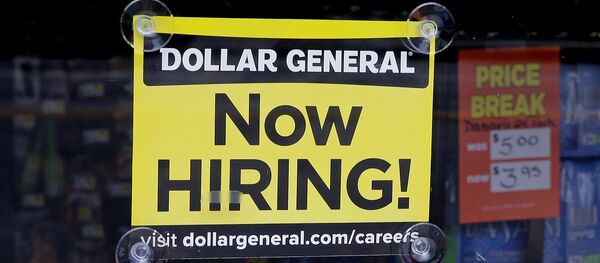Kristian Rouz – Albeit US unemployment is near its historic low and the outlook for further job growth is positive in the near term, the lack of gains in real disposable salaries and wages continues to hamper the purchasing power and overall quality of life of many Americans.
The US economy slid into the Great Recession roughly a decade ago, and whilst over the past eight years GDP growth has been positive, the recovery has been too fragile, and unemployment too high to encourage businesses to spend more on attracting talent and on their workforce. Now, however, with the unemployment rate at 4.4 percent in June, and 222,000 new jobs created in the same month, compared to earlier predictions of 179,000, it would only be fair to expect sustainable gains in salaries and wages.
Such gains, however, have failed to materialise month after month ever since the US labour market has reached the notional concept of ‘full employment’ (where the jobless rate is below 5 percent).
According to an official report released on Friday, average hourly wages added only 2.5 percent year-on-year in June, having slowed in the past two quarters, and are now barely outpacing the near-2 percent inflation.
"There is no shortage of explanation as to why wage growth remains tepid – shadow slack, reduced bargaining power due to globalisation, de-unionization, automation, etc. – but what is puzzling is that wage growth, at least according to the average hourly earnings measure, was clearly accelerating in 2015 and 2016," Michael Feroli of JPMorgan wrote in a note.
Growth in salaries and wages has been held back by the actual decline in US labour productivity in recent years, according to the Federal Reserve’s observations, meaning that an average employer would have to hire more workers to maintain the same output levels. This also explains how the ever-strengthening labour market is not translating into higher consumer confidence: even though more people have jobs, many of these jobs are lower-paying ones, and provide little to no significant gains in purchasing power.
US labour productivity had been rising by 1 percent per year between 2005 and 2012, and productivity growth has slowed to 0.5 percent per year since 2012. For comparison, during the economic prosperity of 1990-2004, interrupted by several minor recessions, US annual productivity growth was 2 percent.
“This is not a market we have typically seen,” Michael Stull of Manpower North America, a recruiting company, said. “We have not before seen unemployment drop, low participation rates and wages not move. That tells you something’s not right in the labour market.”
US labour participation rate, or the share of American civilians aged 16 or older and working or actively looking for a job, is currently at 62.8 percent as of June, which is, albeit higher than 62.7 percent observed in May, is still near 50-year lowest. This also means that even though the current unemployment figures might suggest possible labour shortages in the US economy, many non-participants might rejoin the labour market at any moment, of which employers are well aware.
Subsequently, many people who have a job find themselves in a situation where they have to embark on a one-hour drive to a $10/hour job, as Manpower North America’s Stull pointed out. “You need a car for that,” he said, “and you can’t have a car on $10 an hour.”
According to the International Monetary Fund’s (IMF) observations, US workers are only getting some 40 percent of national income in the form of salaries and wages, as of 2015. In 1970, the share of US national income paid out to workers in the form of salaries, was 55 percent. Such shifts are generally explained by automatization, overall change in technology, the decline of industrialism, and the influence of global trade patterns.
Yet, the disposable incomes of US workers could have been higher than they are now had economic growth in the past 8 years been more in line with historical average US GDP growth. The post-Recession recovery has been characterised by a 1.6-percent average annual growth, whilst the US economy has grown at an average 3.3 percent per year. Weak economic growth, in turn, hampers business spending, resulting in stagnant or lower worker compensation.
“This cautious approach to investment may in part reflect uncertainty about the policy environment,” Vice Chairman of the Federal Reserve Stanley Fischer said. “Providing more clarity on the future direction of government policy is highly desirable.”
Wage growth might pick up as soon as the White House and the Federal Reserve coordinate and start implementing their long-overdue economic reforms, but as of now, wage stagnation is poised to linger, barely adding any optimism to the slow automotive sales, shrinking brick-and-mortar shopping centres, and even consumer lenders.



